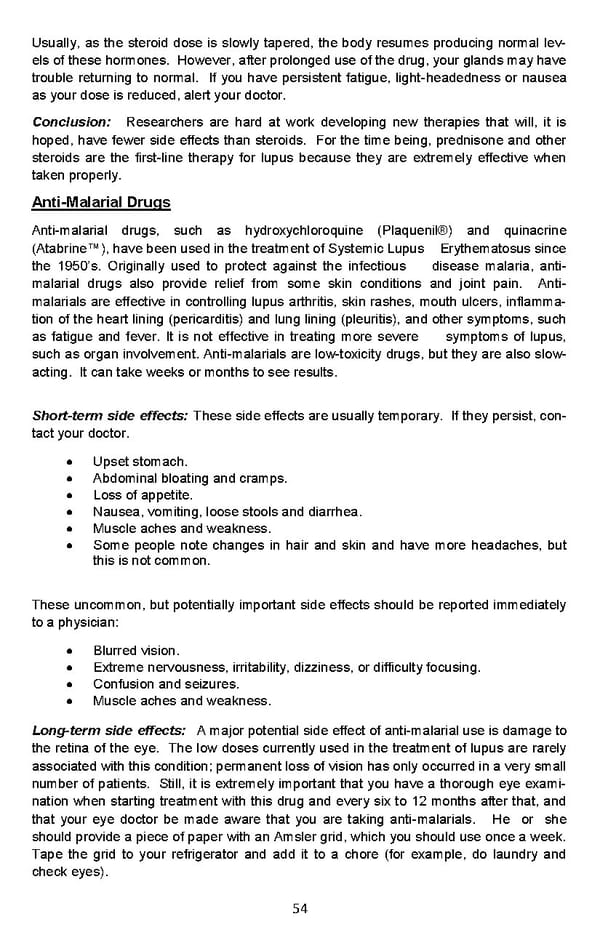Usually, as the steroid dose is slowly tapered, the body resumes producing normal lev- els of these hormones. However, after prolonged use of the drug, your glands may have trouble returning to normal. If you have persistent fatigue, light-headedness or nausea as your dose is reduced, alert your doctor. Conclusion: Researchers are hard at work developing new therapies that will, it is hoped, have fewer side effects than steroids. For the time being, prednisone and other steroids are the first-line therapy for lupus because they are extremely effective when taken properly. Anti-Malarial Drugs Anti-malarial drugs, such as hydroxychloroquine (Plaquenil®) and quinacrine (Atabrine™), have been used in the treatment of Systemic Lupus Erythematosus since the 1950’s. Originally used to protect against the infectious disease malaria, anti- malarial drugs also provide relief from some skin conditions and joint pain. Anti- malarials are effective in controlling lupus arthritis, skin rashes, mouth ulcers, inflamma- tion of the heart lining (pericarditis) and lung lining (pleuritis), and other symptoms, such as fatigue and fever. It is not effective in treating more severe symptoms of lupus, such as organ involvement. Anti-malarials are low-toxicity drugs, but they are also slow- acting. It can take weeks or months to see results. Short-term side effects: These side effects are usually temporary. If they persist, con- tact your doctor. • Upset stomach. • Abdominal bloating and cramps. • Loss of appetite. • Nausea, vomiting, loose stools and diarrhea. • Muscle aches and weakness. • Some people note changes in hair and skin and have more headaches, but this is not common. These uncommon, but potentially important side effects should be reported immediately to a physician: • Blurred vision. • Extreme nervousness, irritability, dizziness, or difficulty focusing. • Confusion and seizures. • Muscle aches and weakness. Long-term side effects: A major potential side effect of anti-malarial use is damage to the retina of the eye. The low doses currently used in the treatment of lupus are rarely associated with this condition; permanent loss of vision has only occurred in a very small number of patients. Still, it is extremely important that you have a thorough eye exami- nation when starting treatment with this drug and every six to 12 months after that, and that your eye doctor be made aware that you are taking anti-malarials. He or she should provide a piece of paper with an Amsler grid, which you should use once a week. Tape the grid to your refrigerator and add it to a chore (for example, do laundry and check eyes). 54
 Living Well With Lupus Facts Booklet Page 53 Page 55
Living Well With Lupus Facts Booklet Page 53 Page 55